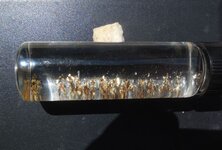Ashman
Full Member
- Apr 11, 2012
- 182
- 83
- Detector(s) used
- AT-Pro & F75-SE
- Primary Interest:
- All Treasure Hunting
I do have some gold in here and I believe there is also some pyrite. I have busted up 3 small rocks to get this point. But before I keep going and end up with a mason jar full of pyrite, I wanted to know if there is an easier way to remove any of the pyrite.
When I panned it out I removed all the small pieces that kind of flutter or seemed to be floating. I was also told another way to tell if it pyrite it will certainly shine in the sun but when you change your point of view or cast a shadow gold will still shine as gold. Pyrite will however darken or lose its gold color.
My issue is a lot of this is gold flake. So small super thin flakes seem to flutter some and some of these small pieces even though the gold color or shine seems to be lost when I cast a shadow, the small pieces when acid tested seemed to hold up. So then those pieces that seem to act like pyrite to the eye were actually gold, well according to an acid test.
At a complete lost, was wondering if I made a home made smelter, if I could get it hot enough to melt gold, what would happened to any pyrite ? Or is this not even an option for what I am trying to accomplish. I am not chemical freak and honestly all that stuff scares the hell out of me, when people start talking about using certain chemicals to separate the gold,,,, UUUUGGGGHHHH

When I panned it out I removed all the small pieces that kind of flutter or seemed to be floating. I was also told another way to tell if it pyrite it will certainly shine in the sun but when you change your point of view or cast a shadow gold will still shine as gold. Pyrite will however darken or lose its gold color.
My issue is a lot of this is gold flake. So small super thin flakes seem to flutter some and some of these small pieces even though the gold color or shine seems to be lost when I cast a shadow, the small pieces when acid tested seemed to hold up. So then those pieces that seem to act like pyrite to the eye were actually gold, well according to an acid test.
At a complete lost, was wondering if I made a home made smelter, if I could get it hot enough to melt gold, what would happened to any pyrite ? Or is this not even an option for what I am trying to accomplish. I am not chemical freak and honestly all that stuff scares the hell out of me, when people start talking about using certain chemicals to separate the gold,,,, UUUUGGGGHHHH

Amazon Forum Fav 👍
Upvote
0





